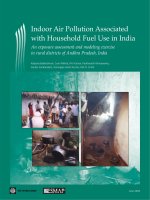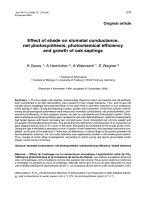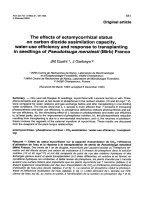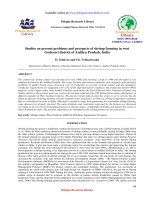Effect of neem coated urea on nitrogen uptake, nitrogen use efficiency and yield of rice under low land ecosystem of godavari delta of Andhra Pradesh, India
Bạn đang xem bản rút gọn của tài liệu. Xem và tải ngay bản đầy đủ của tài liệu tại đây (204.02 KB, 7 trang )
Int.J.Curr.Microbiol.App.Sci (2020) 9(8): 2086-2091
International Journal of Current Microbiology and Applied Sciences
ISSN: 2319-7706 Volume 9 Number 8 (2020)
Journal homepage:
Original Research Article
/>
Effect of Neem Coated Urea on Nitrogen Uptake, Nitrogen Use
Efficiency and Yield of Rice under Low Land Ecosystem
of Godavari Delta of Andhra Pradesh, India
A. Sireesha*, J. Radha Krishna and P. V. Satyanarayana
Regional Agricultural Research Station, Maruteru, West Godavari dt, A.P, India
*Corresponding author
ABSTRACT
Keywords
Nitrogen use
efficiency, Neem
coated urea and
Rice yields
Article Info
Accepted:
20 July 2020
Available Online:
10 August 2020
A field experiment was carried out during the Kharif, 2016 at Regional
Agricultural Research Station, Maruteru to study the Response of applied
neem coated urea (NCU) on nutrient uptake and nitrogen use efficiency of
rice (Oryza sativa L) in low land rice ecosystem of Godavari delta, West
Godavari district of Andhra Pradesh. The experiment was laid out in a
Randomized block design with three replications and eight treatments
namely i.e. 100 % PU (3 equal splits as basal, tillering and PI stage), 75 %
NCU (3 equal splits splits as basal, tillering and PI stage), 100 % NCU (3
equal splits as basal, tillering and PI stage), 125 % NCU (3 equal splits
splits as basal, tillering and PI stage), 100 % NCU (as basal), 100 % NCU
(2 splits as 50 % basal and 50% max. tillering stage) 100 % NCU (2 splits
75% as basal and 25% at maximum tillering stage) and Control (No P60
K40).
Introduction
Rice (Oryza sativa L.) remains the most
important staple food on the planet since it
feeds about half the population on a daily
basis. Fertilizer nitrogen (N) has contributed
an estimated 40% to the increase in per capita
food production over the past 50 years
(Brown, 1999; Smile, 2002).As nitrogen (N)
is major most limiting plant nutrient directly
influences the growth, development, yield and
quality of crops in different cropping systems.
The efficiency of urea is a serious problem
both in direct seeded rice in rainfed system as
well as recovery of applied fertilizer N in
flooded rice soils. N is conventionally applied
to the soil at various stages in splits before
transplanting to panicle initiation stage.
Nitrogen use efficiency in rice rarely exceeds
30- 40 per cent. The improvement in the N
efficiency is, therefore, of prime importance,
not only for achieving and sustaining high
crop grain yield but also to protect the natural
resources from degradation.
2086
Int.J.Curr.Microbiol.App.Sci (2020) 9(8): 2086-2091
Neem has nitrification inhibiting properties
(Deva Kumar and Mukherjee, 1985; Santhi et
al., 1986) and neemcake-coated urea shows
more effectiveness than prilled urea for rice
and other crops. With the current thrust on
sustainable agriculture and organic farming,
the use of natural products like neem has
achieved a great practical significance,
especially in augmenting the N-use efficiency
which abysmally low, around 20-40% under
our predominantly sub-tropical agriculture.
Therefore a field study was undertaken to
study the effect of nitrogen levels and the
modified urea materials on productivity and
nitrogen-use
efficiency
of
lowland
transplanted rice.
Materials and Methods
A field experiment was carried out during the
Kharif, 2016 at the Regional Agricultural
Research Station, Maruteru to study the
Response of applied neem coated urea (NCU)
on nutrient uptake and nitrogen use efficiency
of rice (Oryza sativa L) in low land rice
ecosystem of Godavari delta. The soil of
experimental site is represented as a clay loam
texture. Initial soil characteristics of top-soil
(0–15 cm layer) was neutral in reaction (pH
7.19), electrical conductivity 0.57 dSm-1, soil
organic carbon 1.15 %, available N 149 kg/ha
(Subbiah and Asija 1956), available P2O5
66.30 kg/ha (Olsen et al., 1954) and available
K2O 364 kg/ha(N-N NH4OAc-extractable
K). The experiment was laid out in a
Randomized block design with three
replications and eight treatments 100 % PU (3
equal splits as basal, tillering and PI stage), 75
% NCU (3 equal splits as basal, tillering and
PI stage), 100 % NCU (3 equal splits as basal,
tillering and PI stage), 125 % NCU (3 equal
splits splits as basal, tillering and PI stage),
100 % NCU (as basal), 100 % NCU (2 splits
as 50 % basal and 50% max. tillering stage)
100 % NCU (2 splits 75% as basal and 25%
at maximum tillering stage) and Control (No
P60 K40). The variety used in this experiment
was MTU-1061 (Amara). Recommended dose
of fertilizer for rice in Godavari zone of
Andhra Pradesh was 90-60-40 kg NPK per
Ha.
Results and Discussion
Effect of neem coated urea on grain and
straw yield of rice
There was a significant increase in the grain
and straw yields of rice with an increase in
level of nitrogen. There was significant
highest grain yield of rice 5733 kg/ha was
recorded with 125 % neem coated urea which
was on par with 100% and 75% neem coated
urea applied in three equal splits as basal, at
maximum tillering stage and Panicle initiation
stage (5550 and 5133 kg/ha as respectively).
Application of coated urea materials, e.g.
neemcake-coated urea and neem oil emulsioncoated
urea,
irrespective
of
the
concentrations, had beneficial effects on grain
and straw yields of rice. Singh and & Singh
(1991) and Panigrahi and Dixit (1991) also
reported superiority of neem-coated urea
materials to the prilled urea (Table 1).
Effect of neem coated urea on nutrient
content and uptake of rice
There was not much variation in nutrient
content of rice grain and straw, however, the
total N, P and K uptake was significantly
higher in 125 % NCU (3 splits). In case of
nitrogen, maximum uptake was found in 125
% NCU (3 splits) 101.38 kg ha-1 followed by
100% NCU (3 split) 100.53 kg ha-1, 75%
NCU (3 splits) 95.17 kg ha-1 and lowest from
control (No nitrogen) 35.36 kg ha-1.
Phosphorus and Potassium uptake also
followed the same trend. With regard to
different N source, neem cake blended urea
recorded the highest uptake and prilled urea
recorded the lowest uptake. Upadhyay and
2087
Int.J.Curr.Microbiol.App.Sci (2020) 9(8): 2086-2091
Tripathi (2000), Shivay et al., (2000) and
Thind et al., (2010) also found superiority of
NCU over ordinary urea in N uptake and
nitrogen use efficiencies (Table 2-4).
Effect of neem coated urea on nitrogen use
efficiency
Nitrogen use efficiency (NUE) followed the
similar trend (Table 5) as that of grain yield
and recorded higher NUE in 125% NCU
(3split) 33.01 % followed by 100 % NCU
(3split) 32.59 %, 75% NCU (3 split) 29.41%
and 100% prilled urea 20.68 %. With regard
to NUE, Khanna et al., (2000) found that
neem based product coated urea on rice
produced the maximum grain yield and N use
efficiency (30.21 kg grain/kg N), which was
significantly superior to prilled urea (PU), and
higher N use efficiency. Similarly Singh and
Shivay (2003) reported that coated urea with
neem formulations not only increased the
grain yield, but also increased NUE and
apparent N recovery. Kumar et al., (2011) and
Pushpanathan et al., (2005) also reported
similar finding.
Effect of neem coated urea on soil nutrient
status
Post harvest soil analysis data revealed that,
soil nitrogen status was high with the
treatment receiving 125% Nitrogen applied as
neem coated urea followed by 100 % NCU.
Control plot recorded the lowest soil nitrogen
status. Raj et al., (2014) found that neem cake
blended urea maintained high available N
status in the soil compared to other slow
release forms of urea. Prilled urea maintained
lower N status.
Table.1 Effect of application of neem coated urea on grain and straw yield (kg/ha)
during kharif-2016
Treatments
T1
T2
T3
T4
T5
T6
T7
T8
100% Prilled Urea (PU) - 3Splits(Basal, max.
tillering and PI )
75% Neem coated urea (NCU) - 3 Splits (Basal,
max. tillering and PI)
100% NCU (3 Splits - Basal, max. tillering and
PI)
125% NCU(3 Splits - Basal, max. tillering and
PI)
100% NCU (Full Basal)
100% NCU (2 Splits - 50%- Basal + 50%- max.
tillering)
100% NCU (2 Splits -75% Basal+25% max.
tillering)
Control (No nitrogen fertilizer application (only
P and K)
Mean
C.V (%)
C.D (0.05)
2088
Grain yield
Kg/ha
4850
Straw yield
Kg/ha
6069
Panicles/m2
5133
6811
226
5550
7190
242
5733
7393
249
3767
3833
5460
5542
182
207
4367
6199
215
2400
3074
151
3959
14.3
588
5304
11.0
719
187
16.6
21.6
217
Int.J.Curr.Microbiol.App.Sci (2020) 9(8): 2086-2091
Table.2 Effect of application of neem coated urea on N, P and K content in grain and straw
during kharif-2016
Treatments
T1
T2
T3
T4
T5
T6
T7
T8
Content (%)
100% Prilled Urea (PU) - 3Splits(Basal, max.
tillering and PI )
75% Neem coated urea (NCU) - 3 Splits (Basal,
max. tillering and PI)
100% NCU (3 Splits - Basal, max. tillering and PI)
125% NCU(3 Splits - Basal, max. tillering and PI)
100% NCU (Full Basal)
100% NCU (2 Splits - 50%- Basal + 50%- max.
tillering)
100% NCU (2 Splits -75% Basal+25% max.
tillering)
Control (No nitrogen fertilizer application (only P
and K)
Mean
C.V (%)
C.D (0.05)
N
0.95
Grain
P
0.28
K
0.24
N
0.40
Straw
P
0.14
K
1.23
0.96
0.28
0.23
0.43
0.14
1.20
1.09
1.03
0.87
0.83
0.30
0.29
0.28
0.28
0.24
0.24
0.23
0.24
0.45
0.48
0.41
0.32
0.16
0.16
0.14
0.14
1.21
1.22
1.17
1.20
0.99
0.28
0.21
0.41
0.16
1.18
0.60
0.30
0.24
0.35
0.14
1.19
0.81
6.74
0.10
0.25
14.34
0.06
0.21
16.10
0.06
0.36
13.85
0.09
0.13
18.27
0.04
1.07
6.34
0.12
Table.3 Effect of application of neem coated urea on N, P and K uptake by grain and straw
during kharif-2016
Treatments
T1
T2
T3
T4
T5
T6
T7
T8
100% Prilled Urea (PU) - 3Splits(Basal,
max. tillering and PI )
75% Neem coated urea (NCU) - 3 Splits
(Basal, max. tillering and PI)
100% NCU (3 Splits - Basal, max. tillering
and PI)
125% NCU(3 Splits - Basal, max. tillering
and PI)
100% NCU (Full Basal)
100% NCU (2 Splits - 50%- Basal + 50%max. tillering)
100% NCU (2 Splits -75% Basal+25%
max. tillering)
Control (No nitrogen fertilizer application
(only P and K)
Mean
C.V (%)
C.D (0.05)
N
50.88
Nutrient Uptake (kg/ha)
Grain
Straw
P
K
N
P
15.00
12.66
25.83
9.03
K
78.66
55.79
16.18
13.47
29.38
9.35
81.40
67.98
18.56
15.24
32.55
11.82
87.46
66.19
18.60
14.97
35.19
11.89
90.53
38.57
37.59
12.52
12.78
10.23
10.67
22.40
17.77
7.66
7.76
64.24
66.39
49.73
14.24
10.69
25.25
9.89
73.11
20.80
10.29
8.13
14.56
5.67
49.31
43.06
16.32
12.27
13.13
19.17
4.40
10.67
20.94
3.91
22.55
16.27
6.41
8.12
21.97
3.12
65.68
12.29
14.10
2089
Int.J.Curr.Microbiol.App.Sci (2020) 9(8): 2086-2091
Table.4 Effect of application of neem coated urea on soil nutrient status during kharif-2016
Treatments
pH
T1
T2
T3
T4
T5
T6
T7
T8
100% Prilled Urea (PU) - 3Splits(Basal,
max. tillering and PI )
75% Neem coated urea (NCU) - 3 Splits
(Basal, max. tillering and PI)
100% NCU (3 Splits - Basal, max.
tillering and PI)
125% NCU(3 Splits - Basal, max.
tillering and PI)
100% NCU (Full Basal)
100% NCU (2 Splits - 50%- Basal +
50%- max. tillering)
100% NCU (2 Splits -75% Basal+25%
max. tillering)
Control (No nitrogen fertilizer application
(only P and K)
Mean
C.V (%)
C.D (0.05)
6.24
E.C
(dS/m)
0.50
OC
(%)
1.23
Available nutrients (kg/ha)
N
P2O5
K2O
195
57.4
305
6.19
0.49
1.26
204
57.5
326
6.46
0.46
1.18
213
57.3
325
6.35
0.51
1.27
217
58.2
317
6.46
6.37
0.54
0.48
1.21
1.20
200
208
57.5
57.6
315
304
6.27
0.50
1.23
204
54.7
308
6.16
0.48
1.15
175
52.4
304
6.31
2.39
0.26
0.50
13.28
0.11
1.08
5.75
0.11
180
7.43
23.5
50.3
6.10
5.36
278
Table.5 Effect of application of neem coated urea on total nitrogen uptake (kg/ha) and nitrogen
use efficiency (%) in rice during kharif-2016
S.No Treatments
T1
T2
T3
T4
T5
T6
T7
T8
100% Prilled Urea (PU) 3Splits(Basal, max. tillering and PI )
75% Neem coated urea (NCU) - 3
Splits (Basal, max. tillering and PI)
100% NCU (3 Splits - Basal, max.
tillering and PI)
125% NCU(3 Splits - Basal, max.
tillering and PI)
100% NCU (Full Basal)
100% NCU (2 Splits - 50%- Basal +
50%- max. tillering)
100% NCU (2 Splits -75%
Basal+25% max. tillering)
Control (No nitrogen fertilizer
application (only P and K)
Mean
C.V (%)
C.D (0.05)
Total Nitrogen
Uptake (kg/ha)
76.71
Nitrogen Use Efficiency
(%)
20.68
95.17
29.41
100.53
32.59
101.38
33.01
60.97
55.36
12.81
10.00
74.98
19.81
35.36
73.81
10.71
11.26
2090
-19.22
9.54
3.11
8.0
38.8
Int.J.Curr.Microbiol.App.Sci (2020) 9(8): 2086-2091
In conclusion, the application of neem coated
urea significantly increased the grain yield of
rice as compared to control (no nitrogen) and
prilled urea. Total uptake of Nitrogen,
Phosphorus and Potassium by plant was
maximum in 125 % NCU (3split), followed
by 100 % NCU (3 splits) and minimum was
noticed under control. Nitrogen use efficiency
was found to be high under the treatments
received neem coated urea.
References
Brown, L. R. 1999. A world watches Institute
Report on Progress toward a sustainable
society, eds. L. R. Brown, C. Flavin,
and H. Hench, 115–132.
Devakumar, C. and Mukcrjce, S.K. 1985.
Nitrification retardation by neemproducts. Neem newsletter. 2: 11 - 14.
Khanna P, Pandey N, Tripathi RS. Relative
performance of soil FYM conditioned
and neem based product coated urea on
grain yield and NUE of transplanted
rice in Vertisols. Agricultural Sc.
Digest. 2000; 20(4):259-260.
Kumar Dinesh, Kumar Deva C, Kumar
Rajesh, Das Aurovinda, Panneer
Selvam P, Shivay YS. Relative
efficiency of prilled urea coated with
major neem (Azadirachta indica A.
Juss) oil components in lowland
irrigated rice of the Indo-Gangetic
plains. Archives of Agronomy and Soil
Science. 2011; 57:61-74.
Olsen SR, Cole CV, Watanabe FS, Dean LA.
Estimation of available phosphorus in
soil by extraction with sodium
bicarbonate. USDA, Circ. 1954, 939.
Panigrahi R.K. and Dixit. L. 199 1. Relative
efficiency of slow-release nitrogenous
fertilizers in rainfed rice (Oryza sativa).
Indian journal of Agronomy 36: 401
403.
Prasad, R.. Devakumar. C. and Shivay. Y.S.
1993.Neem Research and Development.
Randhawa, N.S. and Parmar B.S.
Santhi. S.R.. Palaniappan, Sp. and
(Eds). Society of Pesticide Science,
India.
Pushpanathan
KR,
Vijayakumar
M,
Siddeswaran K. Effect of forms of
fertilizer nitrogen and timing of
application on growth and yield of rice
(Oryza sativa l.) Agriculture Review.
2005; 2:153-156.
Santhi. S.R.. Palaniappan, Sp. and
Purushottaman, D. 1986. Influence of
neern leaf on nitrification in a lowland
rice inhibitors for agriculture, health and
the environ- soil. Plalzt and Soil 93 :
133-135
Shivay YS, Prasad R, Singh S. Effect of
nitrogen levels and neem-oil emulsions
coated urea on growth, yield attributes
and yield of wetland rice. In: Extended
Summary of International Conference
on Managing Natural Resources New
Delhi ICAR. 2000; 3:1340-1342.
Singh. G. and Singh, O.P. 199 1. Effect of
coated urea materials on rainfed low
land transplanted rice (Oryza sativa)
and their residual effect on wheat.
Indian journal of Agronomy (suppl.): 22
1-223.
Smil, V. 2002. Nitrogen and food production
proteins for human diets. Ambio 31:
126–131
Subbiah BV, Asija GL. A rapid procedure for
determination of available nitrogen
status in soil. Current Science. 1956;
25:259-260.
Thind HS, Singh Bijay Pannu, Singh RPS,
Yadvinder Singh, Varinderpal Gupta,
Vashistha RK. Relative performance of
neem (Azadirachta indica) coated urea
vis-à-vis ordinary urea applied to rice
on the basis of soil test or following
need based nitrogen management using
leaf colour chart. Nutrient Cycling in
Agro ecosystems. 2010; 87:1-8.
Upadhyay SK, Tripathi KS. Response of
2091
Int.J.Curr.Microbiol.App.Sci (2020) 9(8): 2086-2091
prilled and neem extract coated urea
application timings to rice (Oryza
sativa), Agric.
20(2):84-86.
Sci.
Digest.
2000;
How to cite this article:
Sireesha, A., J. Radha Krishna and Satyanarayana, P.V. 2020. Effect of Neem Coated Urea on
Nitrogen Uptake, Nitrogen Use Efficiency and Yield of Rice under Low Land Ecosystem of
Godavari Delta of Andhra Pradesh. Int.J.Curr.Microbiol.App.Sci. 9(08): 2086-2091.
doi: />
2092









